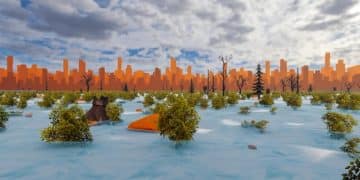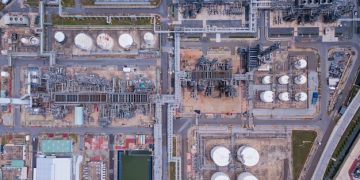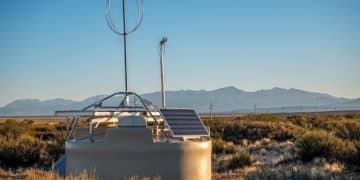US Climate Accord: Meeting 2030 Emissions Goals?
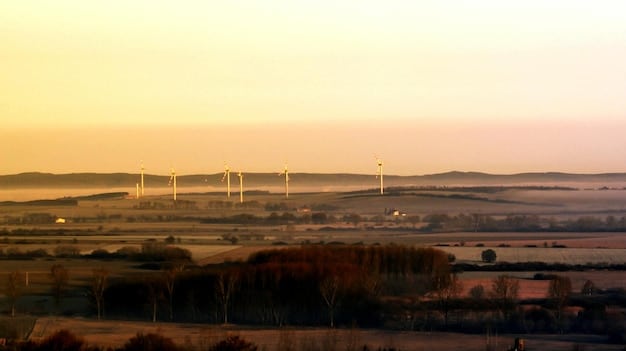
US Climate Accord Updates: Are We on Track to Meet the 2030 Emissions Goals? The US aims to reduce emissions by 50-52% below 2005 levels by 2030, but progress is uneven across sectors, with challenges in electricity and transportation, requiring strengthened policies for achieving the targets.
The United States has set ambitious goals for reducing greenhouse gas emissions as part of the global effort to combat climate change. A key target is to achieve a 50-52% reduction from 2005 levels by 2030. But are the United States actually on track to meet these ambitious goals, and what challenges and opportunities lie ahead? This article will delve into the recent **US Climate Accord Updates: Are We on Track to Meet the 2030 Emissions Goals?** and the pathway to a sustainable future.
Understanding the US Climate Accord Goals
The US Climate Accord, officially known as the Nationally Determined Contribution (NDC) under the Paris Agreement, represents the United States’ commitment to reducing greenhouse gas emissions. This commitment involves a significant restructuring of the nation’s energy and economic sectors.
What are the Specific Targets?
The primary target is to reduce emissions by 50-52% below 2005 levels by the year 2030. Achieving this goal requires significant actions across all sectors of the economy.
Why is This Goal Important?
Meeting these targets is vital for several reasons. Firstly, it aligns the US with international efforts to limit global warming to 1.5 degrees Celsius, a threshold beyond which the impacts of climate change become increasingly severe. Secondly, it positions the US as a leader in clean energy innovation, which can spur economic growth and create jobs.

Key Policies Supporting These Goals
Several key policies and initiatives are designed to help the US achieve its climate goals. These include:
- The Inflation Reduction Act: A landmark piece of legislation that allocates billions of dollars towards clean energy and climate resilience.
- Executive Orders: Actions taken by the President to set new standards for emissions and promote renewable energy.
- State-Level Initiatives: Many states have set their own ambitious climate goals and are implementing policies to transition to cleaner energy sources.
Ultimately, the US Climate Accord goals are ambitious but crucial for mitigating the impacts of climate change. Success requires a concerted effort across all levels of government, the private sector, and individual citizens.
Current Progress: Where Does the US Stand?
Assessing current progress toward the 2030 emissions goals involves looking at multiple sectors and comparing current emissions levels to the targeted reductions. The progress is multifaceted, with some sectors showing promise while others lag behind.
Analyzing Emissions Data
Recent data illustrates both progress and challenges. Some sectors have seen a decrease in emissions, thanks to the adoption of renewable energy and energy efficiency measures.
Sector-Specific Progress
Different industries are experiencing varied rates of progress:
- Electricity Sector: Has seen significant reductions due to the shift from coal to natural gas and renewables.
- Transportation: Remains a challenging sector, with emissions still high due to reliance on fossil fuels.
- Industry: Progress is slow, as many industrial processes are difficult to decarbonize.
Challenges and Obstacles
Several challenges have been identified:
- Policy Implementation: Ensuring that policies are effectively implemented and enforced.
- Technological Barriers: Developing and deploying new technologies to reduce emissions in hard-to-decarbonize sectors.
- Political and Economic Factors: Overcoming political resistance and economic barriers to transitioning to a low-carbon economy.
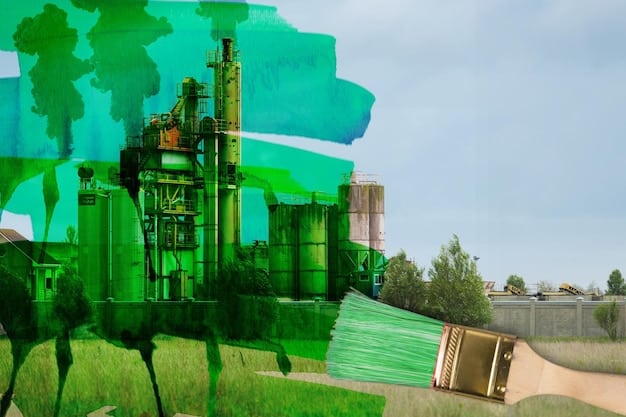
To accelerate progress, the US must address these challenges and implement more aggressive policies. Targeted investments in research and development, infrastructure improvements, and regulatory measures are essential to stay on track for the 2030 emissions goals.
The Role of Renewable Energy
Renewable energy is a cornerstone of the US strategy to reduce emissions. Expanding renewable energy sources is essential for meeting the 2030 goals.
Growth of Solar and Wind Power
Solar and wind energy have seen substantial growth in recent years, driven by technological advancements and falling costs. These sources now represent a significant portion of the US energy mix.
Solar and wind power are also creating new economic opportunities, with job growth in manufacturing, installation, and maintenance.
Policy Support for Renewables
Government policies, such as tax credits and renewable energy standards, have been instrumental in driving the growth of renewables. Further policy support is needed to accelerate deployment and overcome barriers to integration into the grid.
Challenges in Renewable Energy Deployment
Despite the growth and policy support, challenges remain:
- Intermittency: Solar and wind power are intermittent, meaning they are not always available when needed.
- Grid Infrastructure: The existing grid infrastructure needs to be upgraded to accommodate more renewable energy.
- Land Use: Deploying large-scale renewable energy projects can raise land use concerns.
To overcome these challenges, investments in energy storage, grid modernization, and smart grid technologies are essential. Addressing land use concerns will require careful planning and community engagement.
Policy and Regulatory Frameworks
Effective policy and regulatory frameworks are crucial for achieving the US climate goals. These frameworks provide the structure and incentives needed to drive emissions reductions across all sectors.
Overview of Key Regulations
Several key regulations are in place to reduce emissions:
- Clean Power Plan: A rule aimed at reducing emissions from power plants, though its implementation has faced legal challenges.
- Vehicle Emission Standards: Standards set to improve fuel efficiency and reduce emissions from cars and trucks.
The Impact of the Inflation Reduction Act
The Inflation Reduction Act (IRA) has emerged as a transformative piece of legislation, allocating significant funds to boost clean energy and climate resilience. The IRA provides tax credits, grants, and other incentives for renewable energy projects, electric vehicles, and energy efficiency improvements.
Future Policy Needs
To stay on track for the 2030 goals, additional policies are needed:
- Carbon Pricing: Implementing a carbon tax or cap-and-trade system to incentivize emissions reductions.
- Sector-Specific Regulations: Tailoring regulations to address emissions from specific industries, such as manufacturing and agriculture.
- Infrastructure Investments: Upgrading the grid and building out charging infrastructure for electric vehicles.
Effective policy and regulatory frameworks provide the stability and certainty needed to drive investment and innovation in clean energy. Continuous evaluation and adaptation of these frameworks are essential to ensure they remain effective in achieving the 2030 emissions goals.
Technological Innovations for Emissions Reduction
Technological innovation is essential for achieving deep emissions reductions. New technologies can transform how we produce and use energy, reduce emissions from industrial processes, and capture carbon dioxide from the atmosphere.
Carbon Capture and Storage
Carbon Capture and Storage (CCS) technologies capture CO2 emissions from industrial facilities and power plants, preventing them from entering the atmosphere. The captured CO2 can then be stored underground or used for other purposes, such as enhanced oil recovery.
Investment in CCS technologies is growing, with pilot projects and commercial-scale facilities being developed around the world. However, CCS remains expensive and faces challenges related to storage capacity and safety.
Hydrogen Technologies
Hydrogen technologies offer a pathway to decarbonize sectors such as transportation, industry, and power generation. Hydrogen can be produced from renewable energy sources through electrolysis, and it can be used as a fuel for vehicles, industrial processes, and fuel cells.
Other Emerging Technologies
Other promising technologies include:
- Advanced Nuclear Reactors: Smaller, safer, and more efficient nuclear reactors that can provide baseload power without emitting greenhouse gases.
- Energy Storage: Advanced batteries, pumped hydro storage, and other energy storage technologies that can integrate intermittent renewable energy into the grid.
- Direct Air Capture: Technologies that remove CO2 directly from the atmosphere, offering a way to offset emissions from hard-to-decarbonize sectors.
Investing in research, development, and deployment of these technologies is essential for achieving the ambitious emissions reductions needed to mitigate climate change. Collaboration between governments, industry, and academia is crucial to bring these technologies to scale and make them cost-effective.
Economic and Social Considerations
Addressing climate change involves not only technological and policy changes but also careful consideration of economic and social impacts. Transitioning to a low-carbon economy can create new economic opportunities, but it can also pose challenges for workers and communities that rely on fossil fuels.
Job Creation in Green Industries
The transition to a green economy can create millions of new jobs in renewable energy, energy efficiency, electric vehicle manufacturing, and other clean industries. These jobs can provide economic opportunities for workers in communities that are transitioning away from fossil fuels.
Impact on Fossil Fuel Industries
The decline of fossil fuel industries can have negative impacts on workers and communities that rely on these industries. It is important to provide support for workers and communities to transition to new industries.
Providing job training, education, and economic development assistance can help workers and communities adapt to the changing economy.
Environmental Justice
Climate change disproportionately affects low-income communities and communities of color. Policies to reduce emissions and adapt to climate change should be designed to address these disparities and promote environmental justice.
Ensuring that all communities have access to clean energy, clean transportation, and resilient infrastructure is essential for creating a more equitable and sustainable future.
| Key Point | Brief Description |
|---|---|
| 🎯 2030 Goal | Reduce emissions 50-52% below 2005 levels. |
| ⚡ Renewable Energy | Key for emissions reduction, but faces deployment challenges. |
| 🏛️ Policy | Inflation Reduction Act is transformative. |
| 🌱 Technological Advances | Including carbon capture and hydrogen technologies. |
Frequently Asked Questions
▼
The main goal is to reduce greenhouse gas emissions by 50-52% below 2005 levels by 2030, aligning with the Paris Agreement’s objectives.
▼
Progress is being made in the electricity sector due to the shift to renewables, while the transportation sector faces significant challenges.
▼
Renewable energy is crucial, with solar and wind power rapidly expanding, but challenges like intermittency need innovative solutions.
▼
The Inflation Reduction Act provides significant funding and incentives for clean energy and climate resilience projects across the US.
▼
Key innovations include carbon capture and storage, hydrogen technologies, and direct air capture to offset emissions from various sectors.
Conclusion
The US faces both opportunities and challenges in meeting its 2030 emissions goals. While significant progress has been made in some sectors, stronger policies, technological innovations, and a commitment to equitable solutions are essential to achieve these critical targets and contribute to a sustainable future.

